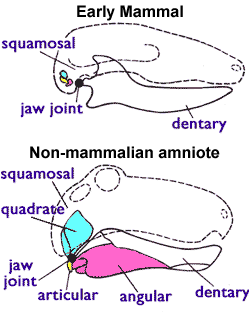Articular bone
The articular bone is part of the lower jaw of most vertebrates, including most jawed fish, amphibians, birds and various kinds of reptiles, as well as ancestral mammals.
Anatomy
In most animals, the articular bone is connected to two other lower jaw bones, the suprangular and the angular.[1] Developmentally, it originates from the embryonic mandibular cartilage. The most caudal portion of the mandibular cartilage ossifies to form the articular bone, while the remainder of the mandibular cartilage either remains cartilaginous or disappears.[1]
Function
In amphibians and reptiles
In most tetrapods, the articular bone forms the lower portion of the jaw joint. The upper jaw articulates at the quadrate bone. [3]
In mammals
In mammals, the articular bone evolves to form the malleus, one of the mammalian ossicles of the middle ear. This is an apomorphy of the mammalian clade,[4] and is used to determine the fossil transition to mammals.[5] It is analogous to, but not homologous to the articular process of the lower jaw.
After the loss of the quadrate-articular joint, the squamosal and dentary bones form the new jaw joint in mammals.[6]
References
- Homberger, Dominique G. (2004). Vertebrate dissection. Walker, Warren F. (Warren Franklin), Walker, Warren F. (Warren Franklin). (9th ed.). Belmont, CA: Thomson Brooks/Cole. ISBN 0-03-022522-1. OCLC 53074665.
- Kardong, Kenneth V. (2012). Vertebrates : comparative anatomy, function, evolution (6th ed.). New York: McGraw-Hill. ISBN 978-0-07-352423-8. OCLC 664665896.
- University of the Cumberlands, QUADRATE AND ARTICULAR EXPRESSION
- "Mammaliformes: Overview - Palaeos". Archived from the original on 2007-04-29.
- Kardong, Kenneth V. (2012). Vertebrates : comparative anatomy, function, evolution (6th ed.). New York: McGraw-Hill. ISBN 978-0-07-352423-8. OCLC 664665896.
- Kermack, D. M. (1984). The evolution of mammalian characters. Kermack, K. A. London: Croom Helm. ISBN 0-7099-1534-9. OCLC 10710687.
